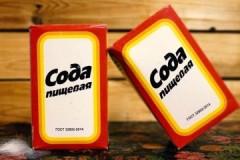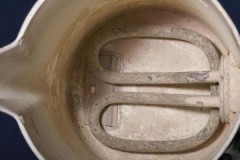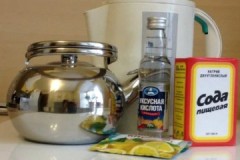Effective ways to remove scale in an enamel teapot at home
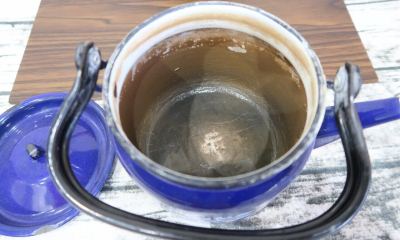 An enamel teapot is a beautiful and convenient dish that is used regularly. When boiling water, even purified water, lime deposits often appear on the inner surface.
An enamel teapot is a beautiful and convenient dish that is used regularly. When boiling water, even purified water, lime deposits often appear on the inner surface.
This is due to the impurities present in the water, which form scale when heated.
It is quite possible to cope with such sediment. How to remove scale in an enamel teapot at home, we will tell you in the article.
Content
Folk recipes
Using the tools and products that are in the household, you can solve the problem with the scale that has formed in the enamel teapot.
The need to remove it is associated with the following circumstances:
- damage to health from ingestion of limescale particles;
- deterioration of thermal conductivity and, as a result, the need for more time for boiling;
- deterioration in the taste of drinks;
- damage to the enamel.
How to remove with citric acid?
Citric acid is not only a food product, but also a tool that allows you to remove scale from various surfaces (from a kettle to washing machines). The advantage of cleaning with this method is high efficiency and lack of toxicity.
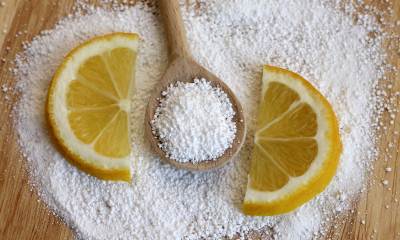 Procedure:
Procedure:
- Add water. There should be enough of it to cover all areas affected by scale.
- Pour in citric acid (3-5 tbsp. L.).
- Boil.
- Set aside from heat.
- After complete cooling, rinse.
To wash off the acid residues, it is advisable to boil clean water in it and pour it out. Read more here.
Vinegar
The acid in the vinegar gives a reaction on contact with lime. As a result, the hard scale breaks down, becomes loose, and is easy to remove.
Cleaning procedure:
- pour water into the kettle;
- add vinegar (1 tbsp. l.);
- stir;
- let stand for half an hour;
- boil;
- let it boil for 10 minutes;
- set aside from the fire;
- drain the water with vinegar;
- rinse the container.
For more information on descaling a kettle with vinegar, see here.
How to clean with baking soda?
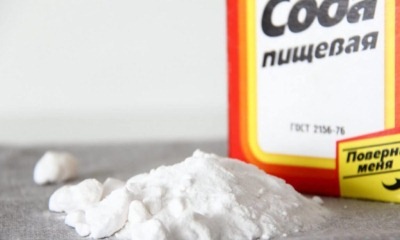 Regular baking soda can also be used to remove plaque from the kettle. With this method, the cleaning method is as follows:
Regular baking soda can also be used to remove plaque from the kettle. With this method, the cleaning method is as follows:
- Pour 2/3 water into the kettle.
- Pour soda (1 tbsp. L.).
- Boil for half an hour.
- Cool down.
- Drain.
- Rinse under running water with a washcloth.
Read more about descaling your kettle with soda. here.
Sweet carbonated drinks
Sprite sodas can also be used for descaling. This application has a limitation - the amount of liquid injected should not fill the kettle by more than ½ the volume.
Application:
- pour a drink;
- boil;
- let stand for half an hour;
- drain;
- rinse with water.
Read more in this article.
Apple (potato) peel
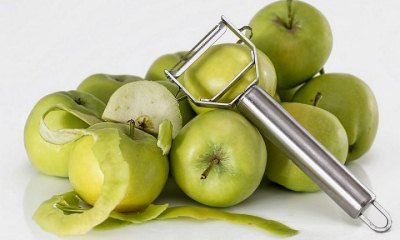 The fruit acids found in apple peelings can be a good descaler in your kettle. For this:
The fruit acids found in apple peelings can be a good descaler in your kettle. For this:
- cleanings are folded inside the container, filling it by ½;
- pour water up to 2/3 of the volume;
- bring to a boil and leave to boil over low heat for an hour;
- cleaning is removed, water is drained;
- the bottom and walls of the inner surface are washed with a sponge.
In addition to apple peels, you can also use pear or potato peels.
Oxalic acid
This product allows you to descale by loosening limescale deposits. Application:
- Fill the kettle with water.
- Add 1 large spoonful of acid.
- Boil.
- Leave to stand for 3-4 hours.
- Drain the solution.
- Rinse the kettle.
Pickle from pickles
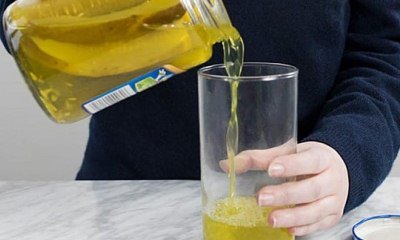 For descaling, undiluted cucumber pickle is suitable. It's easy to use:
For descaling, undiluted cucumber pickle is suitable. It's easy to use:
- Pour the brine into the kettle.
- Boil.
- Set aside from heat.
- Let stand until cooled completely.
- Drain the brine.
- Rinse the inside.
If the specific smell persists, boil again with clean water and drain again.
TOP-3 special tools
Besides simple homemade recipes, you can use cleaning products that are sold by the departments of household chemicals.
Anti-scale Chistin
Anti-scale is a product designed to remove limescale deposits on dishes and electric heating appliances. This drug is produced in Russia. Release form - small, 75 grams, sachets, designed for single use.
In order for the antiscale to work, it is necessary to carry out the following work:
- the powder is diluted in 1 liter of warm, about + 40 ° C, water;
- the resulting solution is poured into a kettle;
- leave for half an hour;
- the kettle is washed in running water.
The cost of 1 sachet is about 40 rubles.
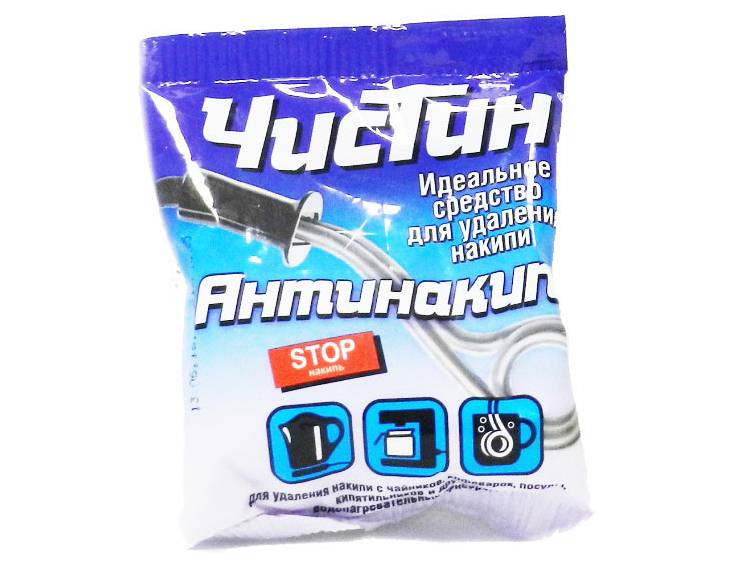
SonixBIO
The drug produced in the Czech Republic is available in liquid form. It is a biodegradable product. Available in packs of 0.25 liters.
Application procedure:
- Pour 1 liter of water into the kettle.
- Pour in SonixBIO (100 to 120 ml), depending on the severity of the situation.
- Warm up to + 50 ° С.
- Set aside for half an hour.
- Drain the solution.
- Rinse the inside.
The price is about 120 rubles per bottle.
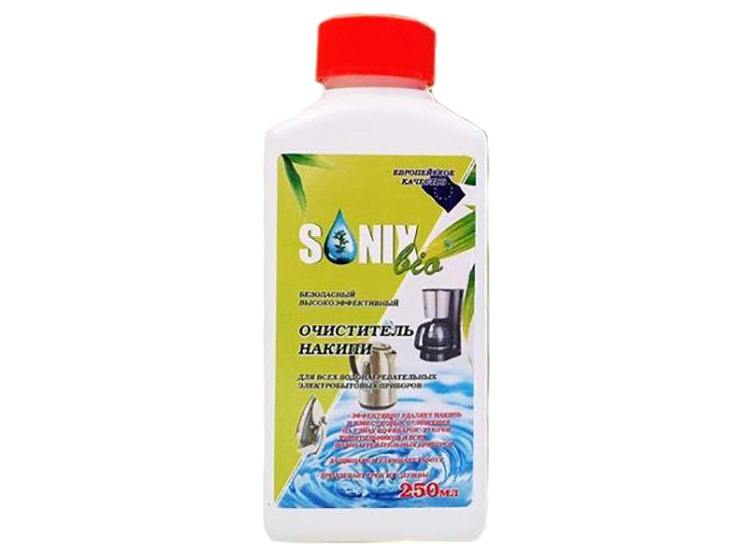
Capsules Un Momento Antiscale
The tool is produced in the Russian Federation. One package contains 5 capsules, each of which is designed for 1 application. Each contains a 10 ml liquid concentrate. It is not a toxic drug that is convenient to use - it cannot be spilled or spilled.
Application procedure:
- pour 1 liter of water into the kettle;
- place the capsule inside;
- boil;
- set aside for 60 minutes;
- Rinse.
Packing price - from 120 rubles.
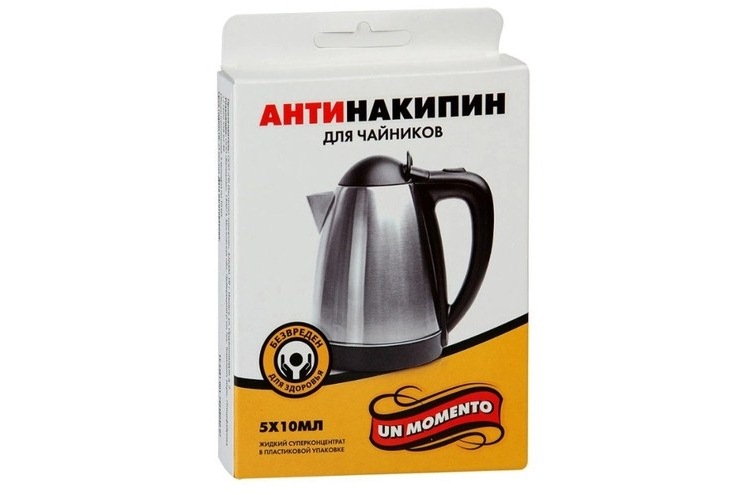
Preventive measures
It is almost impossible to completely prevent the appearance of scale in the kettle. Even in purchased water, or in water that has passed through home filters, there is a certain amount of salts, which, when boiled, form carbon dioxide and a sediment insoluble in water.
Preventive measures include the following:
- For boiling, it is advisable to use only purified soft water.Hard is not only harmful to health, but also forms a large amount of scale.
- Regular washing of the inside of your enamel teapot will help prevent the formation of thick layers of limescale. This will help remove plaque while it is loose.
- Continuous topping up of water in the tank to the remaining water from the previous time will contribute to the rapid formation of lime sediment. The solution to the problem is to rinse the kettle before pouring fresh water into it.
- Repeated boiling of the same water is not desirable.
7 important recommendations
Professional advice to help you stay clean enamel teapot:
- The use of sharp objects to remove the enamel is unacceptable, as this may damage the coating itself.
- If the kettle has chipped enamel on the inside, it makes no sense to descale it, since such dishes should not be used to boil water. Throw it away.
 Removing thick limescale deposits may require several cleaning procedures.
Removing thick limescale deposits may require several cleaning procedures.- You should not use several anti-scale products at once, as damage to the kettle itself and the formation of vapors harmful to health are possible.
- Due to the specifics of the enamel coating, it is advisable to descale regularly, avoiding sediment build-up. Otherwise, the coating on the inside of the kettle may be damaged.
- To clean the kettle, use only products that are approved for cleaning the dishes inside.
- Enamel does not tolerate sharp temperature changes. To prevent it from cracking, you should not immediately draw cold water into it after draining the boiling water from the kettle.
Read about how to descale your kettle. here.
Conclusion
The kettle is used frequently, so limescale can build up very quickly. With regular rinsing and cleaning according to homemade recipes or special products, the dishes will keep clean and not pose a threat to health.
Whichever method of descaling is chosen for implementation, at the end of the work, the kettle must always be thoroughly washed from the inside.

